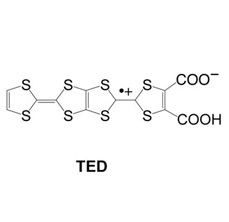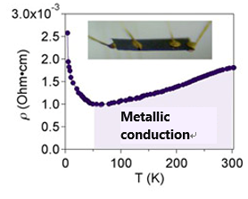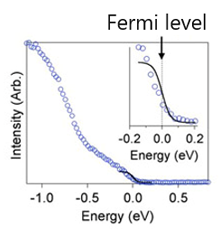Successful Synthesis of Pure Organic Molecules That Shows Metallic Conduction under Ambient Pressure
—Pioneering Development of Organic Materials That Are Highly Conductive, Durable, Stable and Easy to Process—
2016.10.12
(2016.12.01 Update)
National Institute for Materials Science (NIMS)
For the first time in the world, a NIMS research team designed and synthesized single-component pure organic molecules that are conductive like metal under ambient pressure, despite the fact that the molecules contain neither multiple molecules nor metal elements.
Abstract
- For the first time in the world, a NIMS research team represented by Yuka Kobayashi, Principal Researcher, Research Center for Functional Materials, designed and fabricated single-component organic molecules that are conductive like metal under normal pressure, despite the fact that the molecules contain neither multiple molecules nor metal elements. Because the molecules are completely pure, they are more durable and stable compared to conventional chemically doped organic conductive materials. The new molecules may be applied to solar cell electrodes and touch panels.
- Organic molecules consisting solely of light elements essentially do not have carriers by which an electric charge can pass through. As such, they are not high quality conductors. To address this issue, pure organic metals have been synthesized for over 50 years by combining molecules with different properties, thereby altering their individual properties and generating charge carriers. It is well known that Professor Hideki Shirakawa won a Nobel Prize for discovering conductive polymers from among these molecules studied. However, multiple molecules combined together have issues in terms of stability and durability. On the other hand, regarding pure organic materials made of a single component, it was necessary to apply high pressure of at least 1 giga pascal(GPa) in order to make them conductive like metal. In line with this practice, for many years, it had been thought to be extremely difficult to make these materials conductive like metal under ambient pressure.
- Recently, the research team designed new molecules that spontaneously generate holes that can serve as charge carriers. Then the team fabricated pure organic molecules that conduct electricity like metal at a wide range of temperatures under normal pressure. Electrical conductivity of the film that was made exclusively of these molecules (TED as a short name) was 530 S/cm (S = siemens, which is an inverse of resistivity) at room temperature and 1,000 S/cm at 50 K. The conductivity is at the highest level among organic metals. In addition, through molecular orbital calculations, the team found that TED has a prominent spin density gradient which had not been seen in other radical molecules. This electronic state may correlate with the mechanism by which single-component molecules exhibit metallic-conduction properties.
- These findings may set two general directions in the design of highly conductive organic materials. First, a step of adding a chemical dopant for making materials conductive (post-doping) can be eliminated, and consequently, it becomes feasible to design molecules that make it possible to drastically enhance the durability and chemical stability of organic conductive materials. Second, from the viewpoint of practical application, a printable method, a derived printing technique, can be used to easily fabricate highly conductive organic materials.
- This research was conducted as a follow-up of a previous study carried out in line with the Funding Program for Next Generation World-Leading Researchers (NEXT Program; Yuka Kobayashi, project leader) sponsored by the Japan Society for the Promotion of Science.
- This study was published in the online version of Nature Materials on October 10, 2016.

Figure 1. Molecular structure of TED

Figure 2. Temperature dependence of electrical resistivity in TED self-supporting film. Inserted photo shows a self-supporting film with four gold terminals attached.

Figure 3. Density of states of TED measured by ultraviolet photoelectron spectroscopy.
Related files
- Research Center for Functional Materials
Contacts
(Regarding this research)
-
Yuka Kobayashi
Principal Researcher
Research Center for Functional Materials, National Institute for Materials Science
TEL: +81-29-859-2154
E-Mail: kobayashi.yuka=nims.go.jp
(Please change "=" to "@")
(For general inquiries)
-
Public Relations Office
National Institute for Materials Sciences
1-2-1 Sengen, Tsukuba, Ibaraki, 305-0047, Japan
TEL: +81-29-859-2026
FAX: +81-29-859-2017
E-Mail: pressrelease=ml.nims.go.jp
(Please change "=" to "@")
